 Navigating a PH Diagnosis Pulmonary hypertension (PH), a chronic and progressive disease associated with high blood pressure in the pulmonary arteries, can be very difficult to detect and diagnose in routine physical exams. Its symptoms can develop over a long period of time and mimic those of other heart and lung conditions. PH usually develops in individuals between the ages of 20 and 60, but it can occur at any age. Pulmonary arterial hypertension (PAH), in particular, affects women more often than men. PH symptoms are generally not apparent at the onset of the disease, and this may be the case for years to come. Patients affected with PH often go years without a formal diagnosis. This is often due to milder symptoms that come and go with exercise or other physical exertion. Because PH is rare, being diagnosed with the disease can be overwhelming for many individuals. Becoming educated is a good place to start on your PH journey. Whether you are a patient or a caregiver, knowing as much as possible about the disease will help you to be a more active participant in your or your loved one’s healthcare. |
|---|
 Did You Know? According to cardiologist Sanjay Ghandi, MD, congenital heart defects may lead to several complications later in life, including PH. Heart defects can greatly undermine blood flow, contributing to the development of heart disorders and other diseases. Nonetheless, it is not possible to predict when these heart defect complications might arise, if at all. |
|---|
“When I was newly diagnosed, I heard a lot about patients adjusting to a new normal, a lifestyle more suitable for somebody living with a severe pulmonary disease. This notion terrified me. I immediately equated a new normal to slowing down and doing less — two concepts I perceived strictly in a professional context, rather than registering the possibility of any improved health outcomes. My mind refused to comprehend anything beyond that pesky ladder with rungs still left to climb.I can’t help but chuckle at the irony of my struggle to climb metaphorical ladders when I can become short of breath climbing a few flights of stairs. I feel grateful that I’m healthy enough to work and I remain fearful that the day will come when I’m no longer able. In the meantime, I’m challenging myself to set aside the ladder in favor of finding a path that works for me.”— Mike Naple, columnist, “PHighting Words” |
|---|


Classification of PH
There is a wide range of potential causes for PH, and they can affect disease symptoms and its treatment and prognosis.
The World Health Organization divides PH patients into five groups, according to the underlying cause of their disease. These groups include the following:

Group 1: Pulmonary arterial hypertension (PAH)
Group 1 includes PH associated with the narrowing of the small blood vessels in the lungs. This is called PAH and includes cases in which the underlying cause of the narrowing is not known, or idiopathic PAH.
There are several other subgroups in group 1, including the following:
- Familial, or heritable PAH
- PAH caused by certain drugs or toxins
- PAH associated with other conditions, such as connective tissue diseases like scleroderma or lupus, congenital heart problems, chronic liver disease, and certain infections including HIV and schistosomiasis, a parasitic disease
Group 2: PH due to left-sided heart disease
Group 2 refers to PH due to left heart disease, also known as pulmonary venous hypertension. Long-term problems with the left side of the heart can lead to changes in the pulmonary arteries and cause PH.
These may include:
- Left ventricular systolic dysfunction, in which the heart cannot pump blood effectively
- Left ventricular diastolic dysfunction, when the heart cannot properly relax to allow enough blood to flow into it
- Valvular disease, when the valves of the left side of the heart do not work properly, reducing blood flow or allowing blood to flow backwards
Group 3: PH due to lung disease or chronic hypoxia
Group 3 includes PH resulting from lung diseases or a shortage of oxygen in the body, known as hypoxia)
Causes of pulmonary hypoxic hypertension include various lung diseases, such as chronic obstructive pulmonary disease (COPD) and diffuse parenchymal lung disease.
Sleep-disordered breathing, a group of diseases that affect breathing during sleep, like obstructive sleep apnea, are also included in this group. Other causes include repeated exposure to high altitudes, lung developmental abnormalities, and alveolar hypoventilation disorders (marked by a buildup of carbon dioxide and a reduction of oxygen in the lungs’ tiny air sacs).
Group 4: PH due to chronic blood clots
Group 4 refers to PH caused by blood clots obstructing the pulmonary arteries. Clots are the body’s response to bleeding and injuries but can occur without an apparent cause.
Pulmonary embolism occurs when blood clots travel to the lungs from the legs or other parts of the body. These clots restrict blood flow through the lungs, which causes a localized increase in blood pressure in the pulmonary arteries and a reduction in the level of oxygen transported to the rest of the body. The increase in blood pressure means the heart must work harder to pump blood, which can weaken the heart muscles.
This group can also be referred to as chronic thromboembolic PH (CTEPH).
Group 5: PH induced by other health conditions
Group 5 includes causes of PH that do not fit into any of the other four groups. These are widely split into four categories:
- Blood disorders, such as some types of anemia and chronic myeloproliferative diseases (bone marrow disorders wherein excess amounts of blood cells are produced)
- Systemic disorders, such as sarcoidosis — a condition marked by inflammation in various organs, like the lungs and lymph nodes; vasculitis, or blood vessel inflammation; neurofibromatosis, which cause tumors to grow on nerve tissue; and pulmonary Langerhans cell histiocytosis, a rare disorder that progresses to lung scarring
- Metabolic disorders, such as glycogen storage diseases like Gaucher disease (in which fatty molecules accumulate in cells and certain organs)
- Other conditions such as end-stage kidney disease or tumors obstructing pulmonary arteries
 Did You Know? A study published in 2019 found that certain biomarkers may help in diagnosing specific types of PH. Levels of markers known as GDF-15 and suPAR — associated with mechanical stress and damage in the heart — were highest among individuals with Group 2 disease, while H-FABP and BNP — linked to inflammation — were predominantly elevated in individuals with Group 2 or Group 3 PH. Additional research is necessary to determine how these biomarkers and others might aid in quicker diagnosis of PH. |
|---|
“Like everyone else in the rare disease community, we find ourselves in different groups and stages of our disease. … Although other members of the PH community are in the same PHight, our disease has variations, and every intricate detail makes us special. It also explains why treatment is so complicated.It can be easy to compare ourselves with others. But I believe this is one of the worst things we can do, because it leads to self-doubt. Our health journeys aren’t a race or a competition. We need to support one another. Dealing with PH is hard enough, wouldn’t you agree?I believe it is crucial for everyone — chronic illness or not — to compete only with the person who looks back at you in the mirror.”— Jen Cueva, columnist, “Worth the PHight” |
|---|
 Did You Know? Results from a study published in 2018 show that patients with newly diagnosed PH who didn’t previously exhibit symptoms already experience a significant reduction in exercise capacity. Researchers used the incremental shuttle walk distance test, or ISWD, to determine if patients’ exercise capacity was diminished. Further research is needed to determine if the ISWD test might help in detecting PH earlier. |
|---|
“I was lucky to be diagnosed relatively quickly, and I believe it’s partly due to clear communication about the onset and severity of my symptoms. This has been an important lesson throughout my PH journey: the more descriptive I am able to be about my symptoms, the more my team of clinicians are able to help me.”— Eleanor Bird, columnist, “Chronically Uncool” |
|---|
 How Is PH Diagnosed? Because PH symptoms occur in other, less serious conditions, medical professionals sometimes discount the possibility of a patient having PH or attribute the symptoms to other illnesses. As such, PH is considered a medical zebra. Misdiagnoses for PH are common, and patients can sometimes go years without an official PH diagnosis. However, because PH is a progressive disease, early diagnosis is essential to control its progression and provide the best quality of life possible for patients. To diagnose PH, a physician will use a patient’s medical and family histories, a physical exam, and the results of various tests. |
|---|
 Did You Know? A 2019 study found that PH patients in the U.K. experience delayed diagnosis, resulting in considerable financial and emotional implications. Almost half of the study’s participants were diagnosed a year or more after experiencing their first PH-related symptoms. Furthermore, 40% had visits with four or more healthcare professionals before receiving a final diagnosis of PH. |
|---|
“It is common for patients, especially those newly diagnosed, to become inundated with PH. They likely did numerous diagnostic tests and saw multiple specialists before they even received an accurate diagnosis.It’s easy to imagine how this can cloud the way we define ourselves. But despite PH, we all have a purpose and a plan. Those of us with PH are so much more than the disease. I need this gentle reminder at times.”— Jen Cueva |
|---|
 Did You Know? An Austrian study found that four noninvasive parameters may help to diagnose PH. Specifically, a combination of non-right axis ECG deviation, low levels of the heart disease marker NT-proBNP (N-terminal pro brain natriuretic peptide), good oxygen saturation of the blood, and WHO functional class 1 or 2 could rule out the possibility of PH with a probability of 96%. Because the invasive right heart catheterization procedure is necessary for a definitive diagnosis of PH, identifying noninvasive ways to improve the diagnostic process would be useful for clinicians. |
|---|
“I often hear recently diagnosed PH patients express concern about day-to-day changes in their health. I share Cullen’s experiences to help others understand their new normal. Yes, it is common to feel fine one day, awful the next, then well again. I recommend enjoying the good days in moderation and encourage you not to feel guilty on days when you need to rest. Only you and your doctors should judge your health, not others.”— Colleen Steele, columnist, “Life as a Caregiver” |
|---|


You’ve Been Diagnosed With PH; Now What?
Being diagnosed with a rare, progressive disease is life-changing for both patients and their families. Newly diagnosed individuals sometimes experience depression and anxiety following their diagnosis, and all experience a period of adjustment as they adapt to their new normal.
Understanding PH is crucial and allows patients and their caregivers to have some sense of stability in anticipating what to expect going forward.
Ultimately, every PH journey will be different, but having a community of individuals who are navigating similar issues offers patients some comfort and hope.

 Explaining PH to a Loved One Coming to terms with a PH diagnosis is difficult for patients, and having to explain their disease to loved ones adds another layer of uneasiness. Some patients’ PH symptoms may be obvious; others may be mistaken for symptoms of other illnesses. Nonetheless, because the disease is so rare, patients sometimes struggle to describe it. Columnist Colleen Steele reflects on her experience with her son’s PH diagnosis, providing some advice for others. She writes: “People would ask questions that we didn’t know how to answer or comment in ways that left us uncertain as to how to react. This inspired us to do more research and to seek out others in the same situation.” PH education is your best weapon. Playing devil’s advocate doesn’t mean letting repeat verbal offenders, well-meaning naysayers, and parking lot complainers get off without a hitch. Seeing things from their perspective can help calm you before hitting them with your best line of defense: PH education. The PH Association website offers many free resources you can download and share. My family was quick to share the PH wallet fact card and additional information with those who seemed open to learning more than PH basics. I also encourage you to invite family members and caregivers to join the PH forums, where we will answer their questions and concerns with the utmost patience and compassion. We can help you by helping them understand the ins and outs of PH.” |
|---|
 The progressive, incurable nature of PH makes being diagnosed with the disease hard to process. Many people aren’t familiar with PH and its symptoms, so the more that loved ones can research about the disease, the greater the burden that is lifted off newly diagnosed individuals. Understanding patients’ needs and present limitations also helps to support them as they adjust during an unsettling time. Because some patients may experience depression and anxiety following a PH diagnosis, caregivers might consider recommending support groups to their loved ones. In a column reflecting on her PH diagnosis, columnist Jen Cueva asks her husband what advice he would offer to a partner or caregiver of someone newly diagnosed with PH? His response is as follows: “Breathe. Talk to someone. Things will get complicated. Be prepared to go through many emotions. You’ll be mad, sad, happy, confused, all at once. You find yourself asking why on many occasions. Be ready for the bell and fight like hell. Your partner, family member, whoever is going through PH needs you more now than ever before.” |
|---|
 Did You Know? A California study found that support groups for PH positively affected health-related outcomes such as management of symptoms and adherence to medication. While support group participation was not shown to improve quality of life, it did improve other aspects such as self-healing, confidence in self-care, and patients’ understanding of the disease. Attending support groups also allowed patients to gain a better understanding of common PH procedures, such as right heart catheterization. |
|---|
“If I had to condense awareness into one thing, and if there were one piece of wisdom from my previous years that I’d want to share with a new patient or their loved one, I would say this: Be aware that with PH, there is hope.I hope for a day when PH is cured and we no longer need to be aware of it. But for now, being aware of my own hope and miraculous survival feels like enough. If my hope can help you to foster your own, then we are one step closer to defying what we’ve been told. And that feels like half the battle.”— Anna Jeter |
|---|




